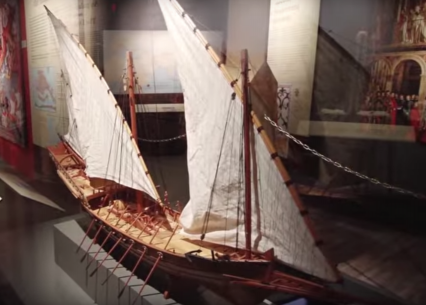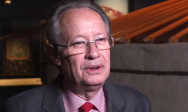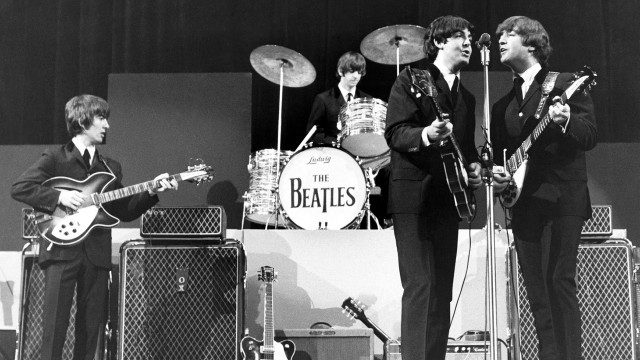Previous exhibition
May 6th, 2014 — October 26th, 2014
Marco Polo - An Epic Journey
Pointe-à-Callière, Montréal’s Archaeology and History Complex, is bringing its visitors an exhibition that will fire their imaginations and take them on an incredible voyage: Marco Polo — An Epic Journey transports visitors to the 13th century, taking them from Venice to China, along a route so astonishing and exceptional that it is still being discussed over seven centuries later.
This event demonstrates the immense impact of the journey described by Marco Polo in the Description of the World, as his accounts allowed for the development of map-making, which in turn led to major exploration of the globe beginning in the 15th century. In fact, the book had a hand in influencing Christopher Columbus to set sail towards the west to open a new route to India and finally discover America in 1492.
Marco Polo, before the big adventure!
Marco Polo was born in Venice in 1254, into a family of merchants. The Polo family was not part of the well-off elite of the day. It was, however, well-versed in matters of trade, having for generations travelled seas controlled by Venice, going as far as Constantinople and beyond, on the shores of the Black Sea. Niccolo and Matteo Polo, Marco’s father and uncle, had made an initial trip to the Orient, coming home in 1269, after having met Emperor Kublai Khan in China. **The
ongolian ruler had entrusted them with the mission of getting him some sacred oil from the lamp of the Holy Sepulchre, bringing back 100 priests capable of convincing people of the superiority of the Christian faith, and a letter from the Pope. They therefore left Venice again to fulfil this mission, this time accompanied by young Marco who had no idea, when he began his journey at the age of 17 in 1271, that he would be 41 years old upon his return in 1295. His journey would take 24 years.
The magnificent voyage described in the Description of the World
Marco Polo travelled over 20,000 kilometres on his journey, going mostly by land and returning by sea. The exhibition gives visitors a chance to experience several stops along the route. And what better guide is there than the explorer’s travelogue, The Travels of Marco Polo or Description of the World, in which Marco Polo tells the story of his voyage, as described to writer Rustichello da Pisa who was imprisoned with Marco Polo in Genoa from 1296 to 1298.
The book is no doubt the most famous travel guide ever written! Landscapes; climates; distances travelled on foot, horse, or camel; dangers; rites and customs; clothing; fauna; flora; festivities in the court of Emperor Kublai Khan… Marco Polo described everything he saw along the way, as well as everything he was told and all that he heard during his many experiences. These memories serve as our guide through the exhibition.
Marco Polo, the risk-taker
The exhibition illustrates the extent to which young Marco Polo was no doubt a risk-taker—courageous, adventurous, and equipped with an iron constitution… all requirements for undertaking such an expedition. Desert crossings, thieves, precarious means of communication, insecurity, harsh climates, and the possibility of falling sick are but a few of the obstacles he had to face on his way to the kingdom of Kublai Khan. The long journey was an extremely difficult and dangerous attempt in the 13th century, with some of the countries along the way still difficult to access in the present day.
A delight for the eyes and the soul—magnificent objects!
Among the over 200 artefacts and objects featured in the exhibition are some that deserve special mention. The first of these—in fact, the most valuable—comes to us from St. Mark’s Basilica in Venice: a perfume burner or lamp of Byzantine influence, transformed into a reliquary of the Holy Blood, dating from the 12th century, reminiscent—given its magnificent cupolas—of St. Mark’s Basilica.
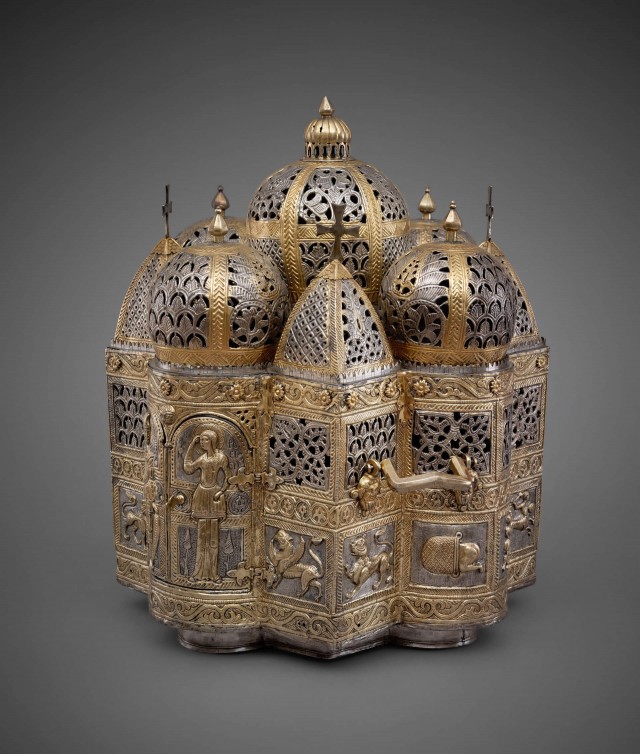
A splendid bronze—very popular in the court of China—from the 13th-15th centuries, depicting a dancing barbarian, is on loan from the Musée Cernuschi in Paris. Silk, a luxurious product from the Orient, is well represented in the exhibition with magnificent pieces from the 12th, 13th, and 14th centuries, lent by the Musée des tissus et des arts décoratifs in Lyon. An enamelled copper shrine or case, which contained a relic of St. Thomas Becket dating to the 13th century, on loan from the Musée de Cluny in Paris. An impressive six-foot tall high relief showing the crucifixion of Christ with Mary, Saint John, and angels, from the 13th-14th centuries, comes to us from the Museo Correr in Venice. Statuettes of women, from 1279, representing people of the court in the era of Mongolian emperor Kublai Khan, are on loan from the Musée d’art et d’histoire in Saint-Denis. From the Cité de la Céramique in Sèvres come several ceramics in the shape of crosses or stars that illustrate the Persian decorative genius.
There are also treasures of rock crystal, gold, and jade—true wonders worthy of princely families — including a pair of winged chimeras dating back to the Liao Dynasty, in the 10-11th centuries, on loan from the Samuel and Myrna Myers collection in Paris. Also on display are saddles from the Émile Hermès collection, each more magnificent than the last. Two were made during the Qing Dynasty (1644-1911), and all demonstrate the importance of the horse—and the wealth of certain horsemen—in Marco Polo’s time.
A central object in the ongoing fascination with Marco Polo’s journey, a facsimile of The Travels of Marco Polo, commissioned by John the Fearless in the years 1410-1412 and lent to us by the Bibliothèque nationale de France, is featured in the exhibition. Illuminations from the book are on display throughout the exhibition, allowing visitors to closely follow Marco Polo’s path. Among these is a very evocative image showing Marco at age 17, astride his horse, between his father and his uncle, as they begin their epic journey. The illustrator quite accurately depicted the seriousness of the goodbyes. One can easily understand what must be going through their minds, wondering if they are ever to return, given the many dangers that await them on the road ahead…
Also of note: Christopher Columbus himself annotated a version of The Travels of Marco Polo, and this precious document is today preserved in Seville.
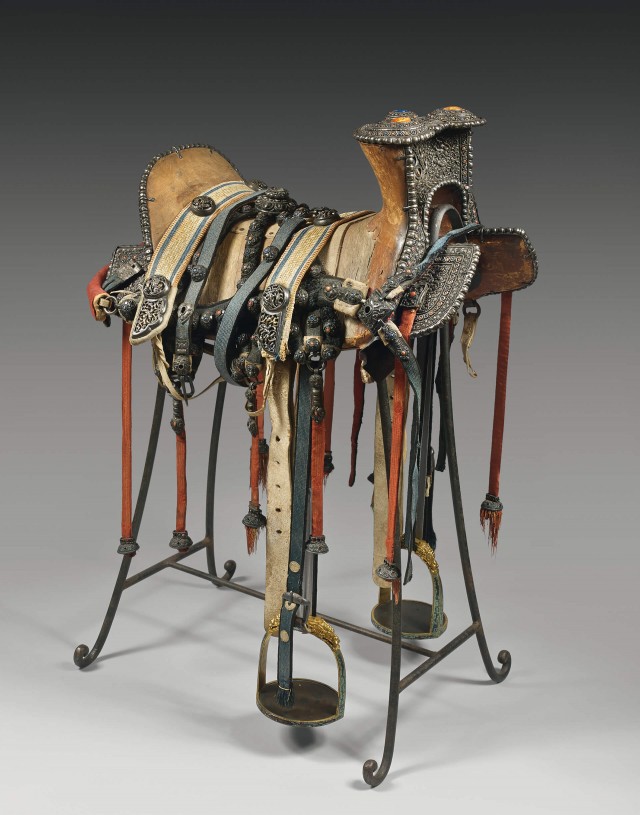
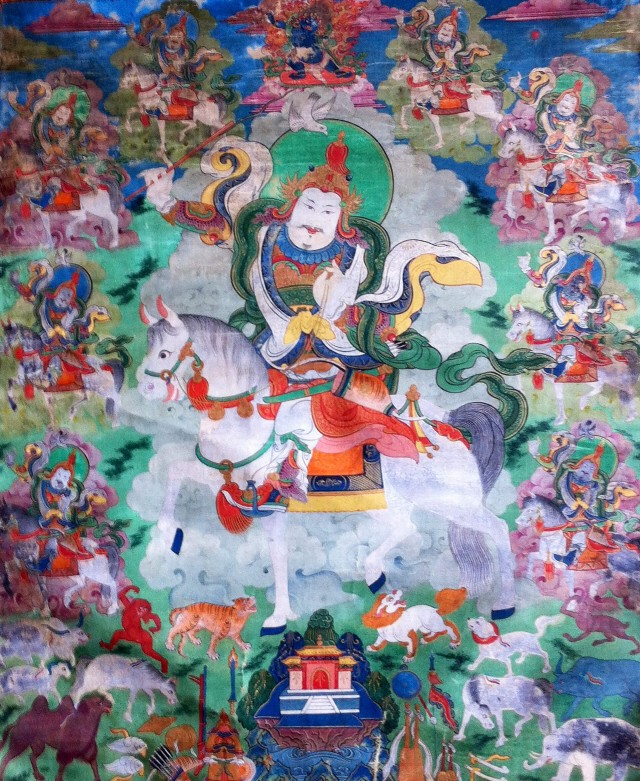
A fascinating journey along the Silk Road
Upon entering the exhibition room, visitors find themselves in 13th century Venice, with a little help from a projection created by Ubisoft. There they learn about the importance of the prosperous city-state of Venice, its maritime and commercial power, and its role in trade between the East and the West. The Earth, or what was known of it at the time, consisted of just three continents: Europe, Africa, and Asia. Along the route, visitors are taken from one place to another, exploring such sublime landscapes as those found along the Silk Road.
Marco Polo was, in fact, one of the first to explore this route that has transcended time and has always held great interest. He brought back precious stones like lapis lazuli from Afghanistan, spices and cotton from India, and jade and silks from China. During his long stay in China, he took note of its people’s many inventions, and brought back a few in his luggage: who today is aware that the Chinese invented paper currency and charcoal?
From Venice to China, by way of Persia, the Mongolian steppe, and the shores of India, visitors explore—as Marco Polo did—the know-how of Europe and Asia’s master craftsmen, and take part in a multi-sensory examination of furs, silks, and woollen fabrics they are invited to touch! The scent of rare spices from exotic places also serves to awaken visitors’ senses. A space representing a magnificent mosque and its evocative objects welcomes visitors to the oasis of Yazd in Persia.
Farther along in the exhibition is the recreation of a Mongolian yurt—a model of adaptability and hospitality—, offering visitors a short break, as well as an opportunity to examine its layout. Other exotic locations await visitors along the way: the Holy Land, where the sacred oil requested by Kublai Khan was found; Armenia and its herds; Georgia and its mountains; Persia and its treasures; Afghanistan, the crossroads of Asia; the Pamir Mountains, which Marco Polo was the first European to cross; and the dreadful Taklamakan Desert.
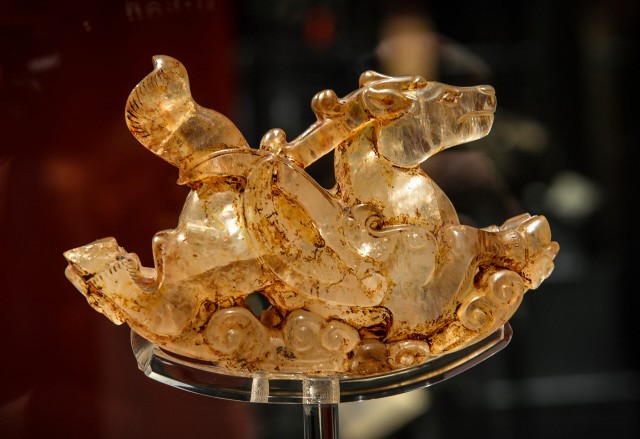
In the Footsteps of Marco Polo
Visitors get a chance to appreciate the challenges the explorer faced in a screening of excerpts from the film In the Footsteps of Marco Polo, produced in 2008 by present-day explorers who followed in Marco Polo’s footsteps over a two-year period. A fascinating experience! In the early 1990s, Denis Belliveau and Francis O’Donnell, two long-time friends from Queens, New York, decided to follow Marco Polo’s path with the explorer’s travelogue as their only guide. They made the long journey on foot, on horseback, and by sea. These two regular guys undertook an extraordinary project that no one else had yet attempted.
A valuable contributor
In producing this exhibition, Pointe-à-Callière would like to thank Jean-Paul Desroches, the exhibition curator. Mr. Desroches worked as the General Conservator at the Musée Guimet in Paris for 35 years, in addition to having been a professor in the Far East department at the École du Louvre for 20 years. For this exhibition, Mr. Desroches lent Pointe-à-Callière a variety of objects from the Mongolian civilization.
Explore the exhibition with Jean-Pierre Desroches (in french)
During its presentation from May 6, 2014 to October 26, 2014, 135 893 people visited this exhibition.
The exhibition Marco Polo – An Epic Journey is produced by Pointe-à-Callière, the Montréal Archaeology and History Complex, and is presented by Domtar. Pointe-à-Callière also thanks the following sponsors: the Department of Culture and Communications, the Department of International Relations and La Francophonie, Air Canada Cargo, Tourisme Montréal, Intercontinental Hotel, Ubisoft, Spice Trekkers, the Italian Cultural Institute of Montréal, The Constantinople Ensemble and La Presse.

